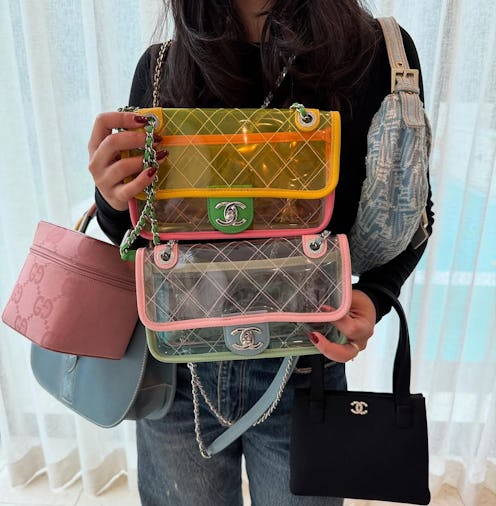Even if you don’t necessarily pay attention to the state of the economy, it’s becoming harder and harder to ignore — especially if you love to shop. With increases in the cost of raw materials and tariffs slapped onto international imports comes a more volatile stock market. But the Dow Jones isn’t the only thing experiencing ups and downs these days. Key players in the fashion industry, like Kering and LVMH, have recently announced drops in their first quarter sales reports — signifying shifts in consumer behavior.
Unless shoppers have unlimited amounts of disposable income (spoiler alert: most do not), it makes sense that they may think twice about making major purchases during such economic uncertainty. However, being smarter with your dollars doesn’t necessarily translate into not shopping at all. As it turns out, fashion lovers are still buying designer items, they’re just taking a different route to get them.
According to Lili Aghaei, founder and curator at The Vintage Marché, “more and more shoppers are turning to the vintage market to buy pre-loved pieces.” Aghaei, who started her online vintage business in 2023, has quickly become a go-to destination for curated designer accessories. When asked why there is more of consumer demand for archival vintage pieces right now she said, “you can enjoy the same iconic luxury without the rising price tag.” Aghaei added, “As a brand that cares deeply about making luxury items more accessible, we are committed to ensuring fair prices on our luxury goods.”
The Vintage Marché’s pricing strategy is working for them: At a time when Kering reported a 25% drop in first-quarter Gucci sales, Aghaei told TZR, “Gucci Tom Ford-era [vintage] pieces are my best-selling, most requested items hands down.” In addition to price, Aghaei believes consumers are looking for more minimal, timeless designs — hence the increased interest for the slim horsebit designs from the ’90s.
Similarly for Samantha Friedman, founder of The Drop — an Instagram-focused shopping account where you can select and buy directly through stories — the recent economic challenges in the U.S. are only motivating her to double down even more. She tells TZR, “For my business, which is centered entirely around secondhand and vintage clothing, these economic shifts are actually reinforcing the relevance and appeal of what I do.”
Without being tied to new production or supply chains, she can continue to offer her customers “rare, high-quality pieces at a fraction of the cost of new designer items,” she says. So as other brands are sending out customer notices on how the tariffs will impact their U.S.-based customers, Friedman can go ahead, business as usual.
With price obviously playing a major factor, there are other reasons shoppers are gravitating towards vintage and archival pieces. Friedman believes that it’s also about wanting to get away from “oversaturation” and wanting more individuality when it comes to style. “These pieces are often one-of-one or one-of-few, and they carry a sense of history, artistry, and authenticity that’s hard to replicate,” she says.
Sara Mark, the entrepreneur behind Sara Nicole Vintage — another Instagram-centric vintage clothing account — believes buyers are also ultimately looking for more sustainable and ethical ways to shop. “There’s no need for such overconsumption and I think people are really waking up to that,” Mark says. “If you have the choice between something non-disruptive or something hurting our world, I think we should all go for the gentler option,” she adds.
With so many upsides to shopping vintage and secondhand, what are you waiting for?
Keep scrolling to shop some of TZR’s favorite vintage accessories picks below.
